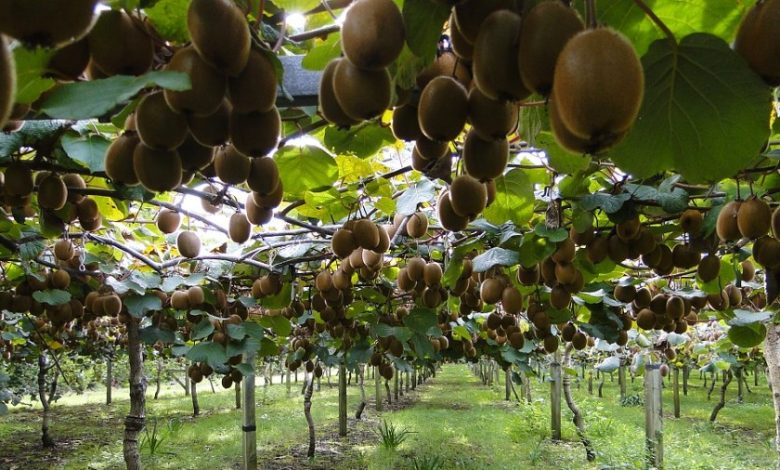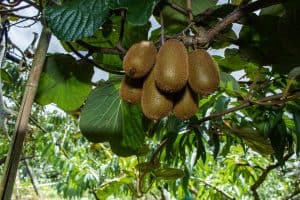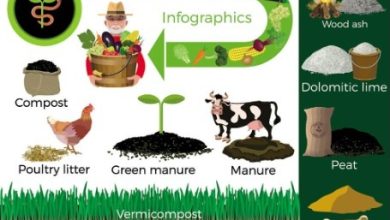How to Plant a Kiwi Tree: Steps to Follow [Images and Much More]

The kiwi is originally from China, but was introduced at the beginning of the last century in New Zealand, a country with which it is commonly identified.
It is a fruit of easy cultivation,especially if you live in a region with moderate winters, as this provides the necessary conditions for it to mature.
While each vine can produce abundant fruit, generallyIt takes between three and seven yearsfor them to reach maturity. If you are interested in planting kiwi plants, in this article we guide you to do it easily and effectively.
Important Points when Sowing Kiwi:
- Where? It needs a lot of light, but it does not do well in direct sun. Partial shade is ideal. more tropical climate.

- When? It can be sown during fall and winter, from late October to mid-February.
- Time to bear the first fruits? About 3 years approximately.
- How do we prepare the land? Kiwi cultivation needs deep, well-drained soils rich in organic matter.
- How do we water? It requires a lot of humidity. It supports it better than drought. Ideal drip irrigation.
- How do we sow? Here step by step.
- How do we harvest? The fruit is harvested in mid-October and early November. When you start it, you have to wait a bit for the fruit to soften and be ready for consumption.
- Plagues and diseases? Nematodes, Botrytis Cinerea and birds.
What do we need to plant kiwi?
When should it be sown?
It can be sown during autumn and winter, atfrom late October to mid-February.
What are the most favorable lighting and temperature conditions?
 It is a temperate climate crop, due to its subtropical nature. It supports low temperatures, so it develops well in areas with short and moderately cold winters, as it allows the plant to accumulate cold hours, which will allow it to sprout strongly.
It is a temperate climate crop, due to its subtropical nature. It supports low temperatures, so it develops well in areas with short and moderately cold winters, as it allows the plant to accumulate cold hours, which will allow it to sprout strongly.
In spring, however, late frosts can be damaging. Likewise, temperatures below -2 ºC, if they remain constant, can prevent the sprouting of fruits.
The Kiwineeds at least 2,000 hours of sunshine per yearto produce quality fruit. However, you don’t want it to be in a place with constant direct sun. It is preferable thatreceive partial shade.
Its optimum growth temperature varies between 25 and 30 ºC.
Likewise, it must be protected from the winds, especially if they are strong.
As for the rains, these can prevent the pollinating effect of birds and bees.
How often should it be watered?
 The Kiwirequires a fairly high relative humiditythat oscillates over 60%, being the optimal percentage of 75%.
The Kiwirequires a fairly high relative humiditythat oscillates over 60%, being the optimal percentage of 75%.
A recommendedlow pressure drip irrigation system. It is also important to have good drainage in the land so as not to generate puddles.
They tolerate humidity better than drought, although waterlogging should be avoided, since it is a crop that is quite sensitive to root suffocation.
Autumn rains in temperate climates improve fruit size and quality.
If you plant it indoors, it is recommended to maintain the relative humidity in the room, by means of humidifiers or frequent spraying of the leaves, so that the natural humidity that the tree loses by not being outside is imitated.
The soil must be kept moist, or alternatively, watered when the superficial layers, the first 5 cm, feel moderately dry to the touch.
How do we prepare the land?
Kiwi cultivation requiresdeep, well-drained soils rich in organic matter.
The ideal soils are sandy loam, without the presence of chlorides because the kiwi shows a certain sensitivity to them.
They grow best in slightly acidic soil with apH between 6.0 and 7.0.
How to plant kiwi step by step
Clear the ground
It removes weeds and remains of previous crops and all kinds of residues to ensure that your kiwi plants receive the correct amount of nutrients.
All the plantsmust be extracted from the rootto prevent them from growing back.
prepare the ground
Moisten the soil before planting kiwis; This reduces the risk of the shoots being moved by the force of the water.
Fertilize the soil. spreada 2.5 cm layer of compost on top of the soil.
Make sure to loosen the soil about 1 meter deep, to ensure the anchorage of the roots.
Put the seeds in the ground
Place each seed at a depth of 2.5 centimeters and cover it with soil. Water immediately to keep the soil moist.
If you plant indoors, make sure to place the pot in a well-lit spot. At firstIt will require between 10 and 12 hours of light per day.
You will have to wait a few months for it to reach a considerable height and be ready to transplant, in case you wish to do so.
If you plant more than one plant, you must leave at least three meters of distance between one and the other.
Protect the tree and give it good maintenance
Water them as soon as you notice that the top layers of the soil are about to dry out.Put up a chain link mesh to protect the plants while they are growing.
You can feed it with an organic fertilizer, such as earthworm humus. In case you think the soil may be lacking in iron, you can add iron sulfate.
Make sure to maintain relative humidity in the environment, if you have the tree indoors.
Remember to protect the tree from strong winds.
Regularly prune plants
 The kiwi tree requires pruning so that it grows stronger and more vigorous.
The kiwi tree requires pruning so that it grows stronger and more vigorous.
Remove old branches and rotten leaves during pruning time, usually done during the winter, before the tree flowers. Dead branches, however, should be removed immediately at any time of the year.
To prune branches, use garden shears to make a clean cut near the base of the branch.
This pruning has the function of guiding the growth of the plant and giving it shape.
fruit thinning
Once your tree begins to bear fruit, you can carry out a regular thinning. Fruit thinning increases production notably. It also serves to suppress fruits that are damaged by diseases, malformations or excessive growth.
Thinning is recommended to be done in summer. To learn more, read: The kiwi blooms.
pollinate your plants
The kiwi is a dioecious plant, so it has male and female individuals. Generally speaking, one male is required for every 5 female plants planted.
The easiest way to promote pollination is by having multiple trees. When you have two or three trees growing together, the bees will begin to carry pollen from one tree to another.
How to harvest kiwi
 Kiwifruit productionIt develops from the third year of planting, obtaining better harvests from the seventh or eighth productive year.
Kiwifruit productionIt develops from the third year of planting, obtaining better harvests from the seventh or eighth productive year.
The fruit is harvested in mid-October and early November. When you start it, you have to wait a bit for the fruit to soften and be ready for consumption.
For its conservation, it is recommended to freeze at a temperature between -2ºC and -2.5ºC and a relative humidity greater than 95%, since otherwise the pulp withers.
To find out more, read: Picking the Kiwis.
Kiwi pests and diseases
Some of the most common pests and diseases that affect kiwi are:
nematodes
They penetrate through the roots producing malformations in them and causing rot.
To control them, we can plant garlic cloves as a repellent. They can also be treated with steam sterilization and solarization.
Botrytis cinerea
It attacks during the flowering period, causing deformations and the fall of flowers and fruits.
It is best to install a drip irrigation system and apply horsetail as prevention.
It also works to eliminate weeds and crop residues, and favor the ventilation of the crop.
birds
For control you can hang pieces of shiny metal or tin sheets that move in the wind from the branches. Compact discs work too. Use scarecrows.
To learn more, read: Kiwi varieties.
How to distinguish female and male kiwi plants?
Male and female flowers grow on separate kiwi plants. Male flowers produce pollen from numerous stamens.
The female flowers have a well-developed ovary with long sticky stigmas in the center. Although the female flowers have stamens, they do not produce functional pollen.
When it comes to determining the sex of kiwi flowers, the female will also have white, well-defined ovaries at the base of the flower, which the males of course lack. The ovaries, by the way, are the parts that develop into fruit.
Male kiwi flowers have a bright yellow center due to their pollen-bearing anthers.
How long does a kiwi live?
Kiwis have a life span of between 70 and 80 years, being productive for approximately 30 years.
How long does it take to grow a kiwi?
The kiwi spends a maximum of 16 years growing to be able to reach up to 9 meters in height.
Can it be grown in a pot?
Yes, it can be grown in a pot, taking care to give it the ideal conditions for its development.
Here it is important to highlight a place to lean on, since it is a plant that develops as a vine.
How many times does a kiwi produce fruit?
Kiwis make an annual production from the second year of life.
The most usual is that the best productions occur after 8 years and remain constant until 30 years later.
Should a kiwi be pollinated to obtain fruit?
Yes. In fact, the kiwi is one of the species for which male and female specimens are needed to achieve pollination.
The good news is that a male specimen is capable of giving enough pollen to pollinate up to 10 female trees.
How cold can a kiwi tolerate?
It is capable of withstanding the cold of winter without problems down to -20° C, as long as it is properly in its torpor phase.
How many kiwis can be planted per hectare?
It is possible to work with up to 600 kiwi specimens on one hectare of land.
What kind of fertilizer does a kiwi need?
You have to work with a balanced NPK fertilizer with 10-10-10 and that is enriched with microelements.
Kiwi is prone to iron, zinc and magnesium deficiency so you have to take care of it.
How much heat and/or drought can a kiwi tolerate?
As it is a kind of temperate climate, it is better that the temperature in hot times does not exceed 30 ° C.
In any case, the humidity of the environment must be maintained at around 60%, even more so before the arrival of summer.
To know more, you can see: Kiwi cuttings.

![Photo of Wormwood: [Cultivation, Irrigation, Care, Pests and Diseases]](https://www.complete-gardening.com/wp-content/uploads/2022/08/wormwood-cultivation-irrigation-care-pests-and-diseases-390x220.jpg)

